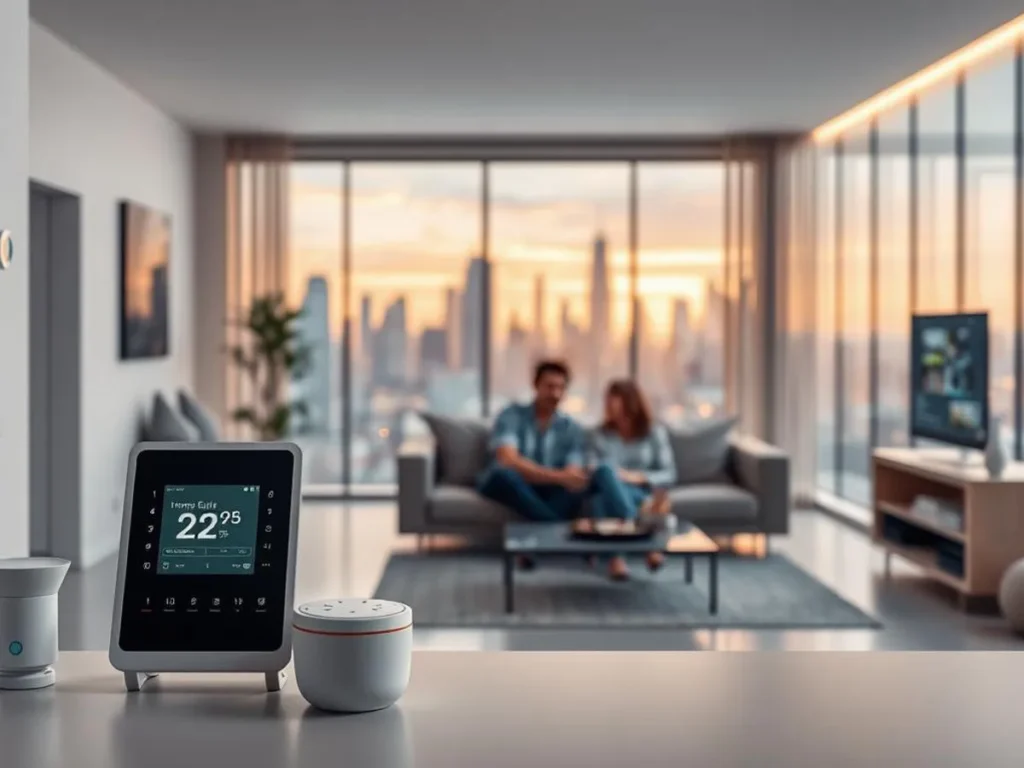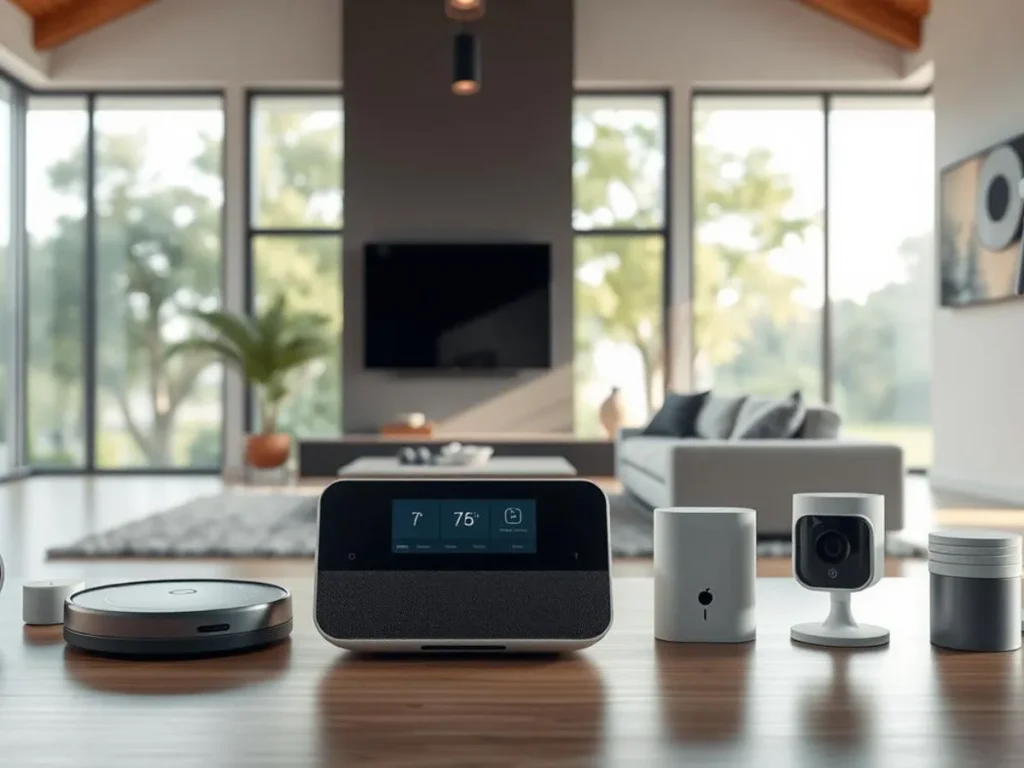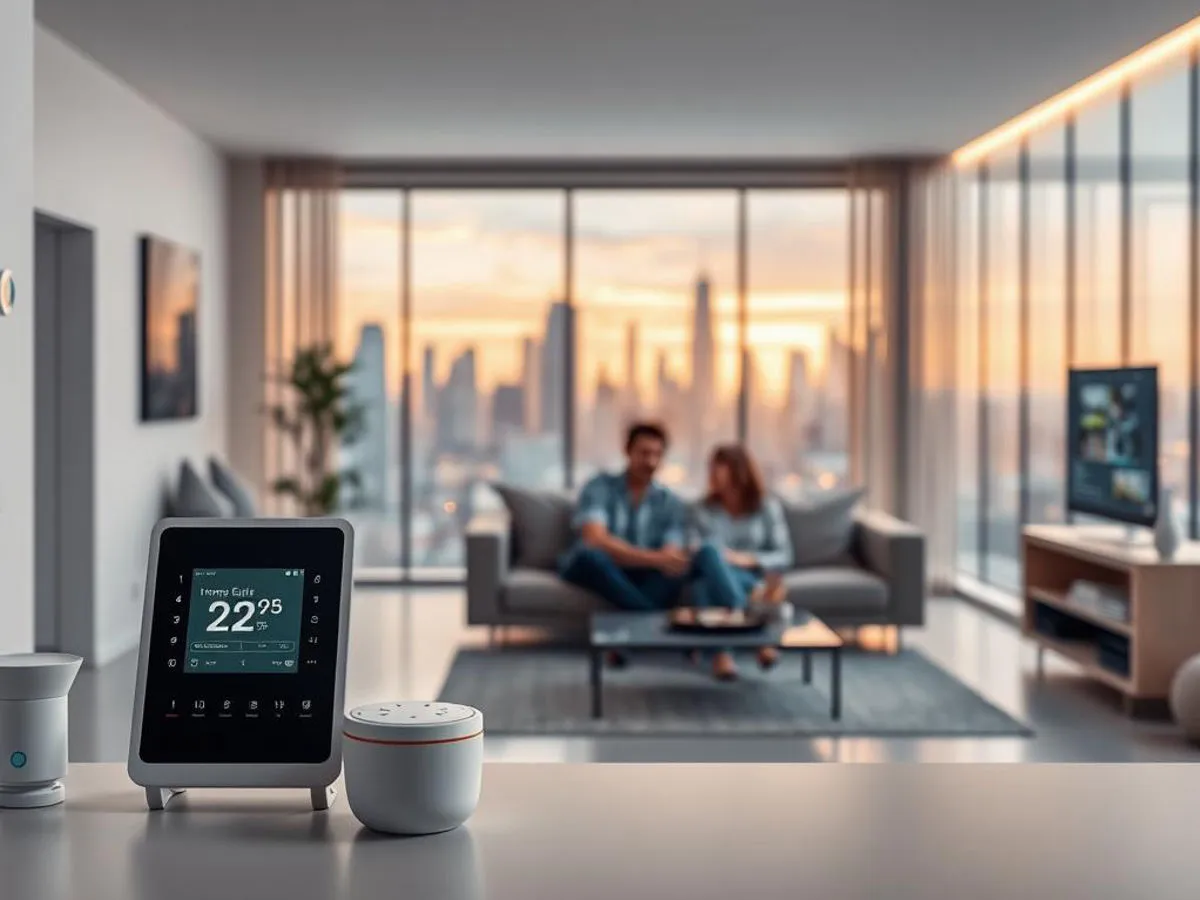Can your home become more intuitive and responsive to your needs without being overly complicated? The answer lies in the integration of artificial intelligence in home automation. This is revolutionising the way we live.
The concept of AI in smart homes is transforming the smart home experience. It makes it more convenient, efficient, and secure. Imagine a home that adjusts its temperature, lighting, and entertainment systems based on your preferences and daily routines.

Table of Contents
In 2025, five innovative tools will take the smart home experience to the next level. These advancements promise to make our lives easier, more enjoyable, and more connected.
The Evolution of Smart Home Technology
The smart home technology landscape has seen significant changes in recent years, thanks to AI advancements. This evolution has changed how we interact with our homes, making them more efficient, secure, and convenient.
From Basic Automation to AI-Powered Systems
The journey of smart home technology started with basic automation. It allowed for simple control over lighting and temperature. But with AI, these systems have evolved. They can now learn and adapt to our preferences.
AI-powered systems can predict and respond to our needs. This has greatly improved our living experience.
Key Technological Breakthroughs of 2020-2025
Between 2020 and 2025, several technological breakthroughs have advanced AI in smart homes. Improvements in machine learning algorithms and data processing capabilities have been key. The integration of IoT devices has also played a crucial role.
These advancements have enabled devices to interact more seamlessly. This has created a more cohesive and intuitive smart home ecosystem. AI-driven innovations have been essential in this progress. They offer enhanced personalisation and efficiency.
Understanding AI in Smart Homes
The integration of AI into smart homes is transforming our living spaces, making them more intuitive and responsive. This change goes beyond simple automation. It’s about creating an ecosystem that learns and adapts to our preferences and habits.
The Shift from Reactive to Predictive Home Systems
Old smart home systems were reactive, responding to commands or schedules. But AI has changed this, making them predictive. Now, they can anticipate and prepare for our future needs, like adjusting the temperature or lighting.
Key features of predictive home systems include:
- Learning occupants’ schedules and preferences
- Anticipating energy needs and optimising usage
- Automatically adjusting settings for comfort and efficiency
How Machine Learning Personalises Your Living Space
Machine learning, a part of AI, is key to personalising our smart homes. It analyses data from sensors and devices, identifying patterns to improve our living environment.
For example, a smart home can learn a family’s daily routine. It adjusts lighting and temperature to suit their needs. It also works with other smart devices, like thermostats and security systems, for a seamless experience.
Benefits of AI-Enhanced Smart Home Systems
AI has transformed smart home systems, making them more efficient and secure. The integration of Artificial Intelligence (AI) in smart home technology has revolutionised our living environments. It offers numerous benefits that significantly enhance our daily lives.
Energy Efficiency and Cost Savings
AI-enhanced smart home systems improve energy efficiency by learning and adapting to your usage patterns. This reduction in energy consumption leads to substantial cost savings on utility bills. For example, AI-powered thermostats can optimise heating and cooling based on your schedule and preferences. This ensures you’re not wasting energy when you’re not home.
Enhanced Security Features
AI-driven smart home security systems provide advanced security features, making your home safer. These systems can detect anomalies in real-time and alert you to potential security breaches. They can also automatically notify emergency services if necessary. AI-powered cameras can distinguish between familiar faces and strangers, enhancing your home’s security.
Convenience and Time-Saving Advantages
AI-enhanced smart home systems also offer significant convenience and time-saving advantages. With voice-controlled assistants, you can manage various aspects of your home, from lighting to entertainment systems, with simple voice commands. This makes your life easier and saves you time for more important activities.
1. Amazon Nexus Home AI Assistant
The Amazon Nexus Home AI Assistant is transforming smart home technology with its cutting-edge AI. It stands as a key player in the future of AI in smart homes. It seamlessly integrates various devices and systems, offering an automated living experience.
Overview: The Central Hub for Home Management
The Amazon Nexus Home AI Assistant acts as the brain of your smart home. It controls and coordinates different smart devices. This central hub enables you to manage your home’s lighting, temperature, security, and entertainment systems from one interface.
Key Features and Capabilities
- Voice Control: Manage your smart home devices with simple voice commands.
- Automated Routines: Create customised routines to automate multiple actions with a single command.
- Smart Home Integration: Compatible with a wide range of smart devices from various manufacturers.
Pros and Cons
The Amazon Nexus Home AI Assistant brings several benefits, including enhanced convenience, improved home security, and energy efficiency. Yet, some users might find a learning curve in fully utilising its capabilities. There are also concerns about data privacy.
Real-World Applications
In real-world scenarios, the Amazon Nexus Home AI Assistant greatly enhances the living experience. It can automatically adjust lighting and temperature based on the time of day and your preferences. This makes your home more comfortable and energy-efficient.
Setup and Integration with Existing Systems
Setting up the Amazon Nexus Home AI Assistant is straightforward, thanks to Amazon’s user-friendly interface and comprehensive guides. It can be integrated with many existing smart home systems. This allows for a gradual upgrade of your smart home infrastructure.
By adopting the Amazon Nexus Home AI Assistant, homeowners can significantly enhance their living environment. They move towards a more automated, efficient, and secure home. This aligns with the future of AI in smart homes.
2. Google Nest AI Learning Thermostat Pro
The Google Nest AI Learning Thermostat Pro is transforming home climate control with its cutting-edge predictive intelligence. This device marks a major advancement in smart home technology. It offers a highly personalised and efficient heating and cooling experience to users.
Overview: Climate Control with Predictive Intelligence
The Google Nest AI Learning Thermostat Pro employs advanced AI algorithms to understand your temperature preferences and schedule. It adjusts your home’s climate based on this information. This predictive intelligence ensures your home is always at the ideal temperature. It boosts comfort and reduces energy waste.
Key Features and Capabilities
- Advanced Temperature Sensing: Accurately detects temperature and adjusts settings for optimal comfort.
- Smart Scheduling: Learns your daily routine and preferences to create an efficient heating and cooling schedule.
- Energy Reports: Provides detailed insights into your energy usage, helping you make informed decisions.
Pros and Cons
- Pros:
- Highly efficient and personalised climate control.
- User-friendly interface and mobile app control.
- Cons:
- Requires a stable internet connection for full functionality.
- It may have a learning curve for some users.
Energy Savings and Environmental Impact
The Google Nest AI Learning Thermostat Pro aims to optimise energy usage, potentially leading to significant savings on utility bills. It minimises unnecessary heating and cooling. This device also helps reduce environmental impact.
Setup and Integration with Existing Systems
Setting up the Google Nest AI Learning Thermostat Pro is easy, thanks to its user-friendly installation process. It integrates seamlessly with many existing smart home systems. This enhances your home’s overall automation and efficiency.
3. Samsung SmartThings Security Guardian
AI-powered home security reaches new heights with the Samsung SmartThings Security Guardian. This system is designed to provide comprehensive protection for homes. It leverages the power of artificial intelligence to enhance security features.
Overview: AI-Powered Home Protection System
The Samsung SmartThings Security Guardian is an advanced home security solution. It uses AI to monitor and protect homes. It offers a range of features that make it an effective tool for home security.
Key Features and Capabilities
The system includes advanced AI-powered sensors and cameras. These can detect and alert homeowners to potential security threats.
- Advanced threat detection
- Real-time alerts
- Integration with other smart devices
Pros and Cons
Pros: Enhanced security, real-time monitoring, and integration with other smart home devices.
Cons: Requires a subscription for full features, potential for false alarms.
Integration with Emergency Services
The Samsung SmartThings Security Guardian can be integrated with emergency services. This allows for rapid response in the event of a security breach.
Setup and Integration with Existing Systems
Setting up the Samsung SmartThings Security Guardian is straightforward. It can be integrated with existing smart home systems, enhancing overall home security.
By integrating AI into smart homes, the Samsung SmartThings Security Guardian exemplifies the benefits of AI in smart home systems. It provides enhanced security and peace of mind for homeowners.
4. Apple HomeKit AI Kitchen Assistant
The Apple HomeKit AI Kitchen Assistant is transforming meal planning and preparation. This is thanks to AI-enhanced smart home technology.
Overview: Revolutionising Meal Planning and Preparation
The Apple HomeKit AI Kitchen Assistant is a game-changer in the kitchen. It offers features that simplify meal planning, grocery shopping, and cooking. Its advanced AI suggests recipes based on your preferences, ingredient availability, and cooking skills.
Key Features and Capabilities
- Recipe Suggestions: Get personalised recipe recommendations based on your preferences and ingredient availability.
- Step-by-Step Cooking Guidance: Follow easy-to-understand cooking instructions to prepare delicious meals.
- Grocery List Management: Automatically generate and manage your grocery lists based on the recipes you choose.
Pros and Cons
The Apple HomeKit AI Kitchen Assistant offers several benefits. It enhances convenience, improves cooking experience, and aids in meal planning. Yet, some users might find the initial setup complex. It also requires a stable internet connection to function optimally.
Dietary Management and Shopping Integration
This device seamlessly integrates with your shopping experience. It allows you to manage your dietary needs and preferences effortlessly. It can also sync with your favourite grocery stores for easy ordering and pickup.
Setup and Integration with Existing Systems
Setting up the Apple HomeKit AI Kitchen Assistant is straightforward. It’s easier if you’re already using other Apple HomeKit devices. It integrates smoothly with your existing smart home ecosystem. This enhances your overall smart home experience with AI for home security and convenience.
5. LG ThinQ Smart Laundry System
Laundry day has never been easier with the LG ThinQ Smart Laundry System. This cutting-edge system is a must-have for any smart home. It’s designed to make laundry day more efficient and less of a chore.
Taking the Work Out of Laundry Day
The LG ThinQ Smart Laundry System simplifies the laundry process. Its advanced AI can detect fabric types, suggest washing cycles, and even order detergent when needed. This makes laundry day a breeze.
Key Features and Capabilities
This system comes with several key features:
- Smart Cycle Detection: Automatically detects the type of laundry and selects the right washing cycle.
- Energy and Water Monitoring: Tracks energy and water usage, offering insights to save resources.
- Automatic Detergent Ordering: Orders detergent when supplies are low, ensuring you’re always prepared.
Pros and Cons
While the LG ThinQ Smart Laundry System offers many benefits, there are some points to consider:
- Advantages: Simplifies laundry, saves energy and water, and integrates with your smart home.
- Disadvantages: Requires a stable internet connection, and the initial cost may be higher than traditional systems.
Water and Energy Conservation Benefits
The LG ThinQ Smart Laundry System optimises water and energy usage. It detects load size and fabric type to adjust cycles, reducing waste. This makes your home more sustainable.
Setup and Integration with Existing Systems
Setting up the LG ThinQ Smart Laundry System is easy. It integrates well with existing smart home systems, creating a cohesive living experience. Just download the LG ThinQ app, follow the instructions, and start enjoying smart laundry benefits.
Integrating Multiple AI Systems in Your Smart Home
Integrating multiple AI systems in a smart home is now essential for convenience and efficiency. Homeowners are increasingly adopting AI-powered devices, making a cohesive ecosystem crucial. This integration allows for better control and monitoring of the home environment.

Compatibility Considerations Between Different Brands
Ensuring compatibility between various AI systems is a major concern. Homeowners need to verify if devices from different manufacturers can work together smoothly. Checking for compatibility before buying new devices can prevent future headaches.
Many smart home devices use common protocols like Zigbee or Z-Wave, making integration easier. Yet, some devices may use proprietary technology, limiting compatibility. Researching compatibility and protocols is key to making smart choices.
Setting Up a Cohesive Ecosystem
To create a cohesive ecosystem, start by identifying your primary AI system or hub. This central hub will manage and coordinate all AI-powered devices. Choosing a hub with broad compatibility makes integration simpler.
After setting up the hub, integrate your AI-powered devices. This involves connecting them to the hub, configuring settings, and automating routines. Ensuring all devices are connected and working properly is vital for a seamless experience.
Privacy and Security Considerations
Integrating multiple AI systems raises privacy and security concerns. It’s crucial to ensure all devices are secured and configured correctly. Regularly updating device software and using strong passwords are essential for protection.
Homeowners should also be aware of the data collected by their devices. Understanding how this data is used and protected is vital. By prioritising privacy and security, homeowners can enjoy their AI-powered smart home while minimising risks.
The Future of AI in Smart Homes: Beyond 2025
Looking ahead to 2025 and beyond, AI in smart homes will become even more integrated and intuitive. The advantages of AI in these systems will expand, simplifying our lives, making them more convenient, and boosting energy efficiency.
AI will make our homes more personalised, adapting to our habits and preferences. This will enhance comfort, security, and energy savings. Homeowners will enjoy a more tailored experience, thanks to AI’s ability to learn and adjust.
Future AI advancements will likely focus on better interoperability among smart devices. This will create a more unified and efficient smart home ecosystem. As AI evolves, we can anticipate more advanced home automation systems that meet our needs instantly.
Homeowners can look forward to a more streamlined, efficient, and enjoyable living experience. With ongoing AI development, the potential for smart home innovations is vast. We can expect to see groundbreaking advancements in the years to come.

